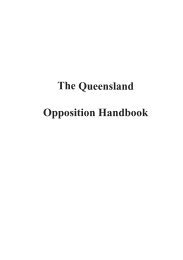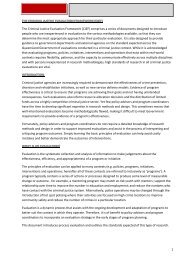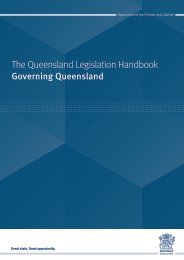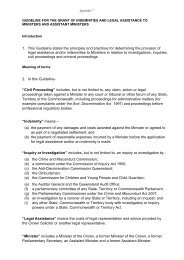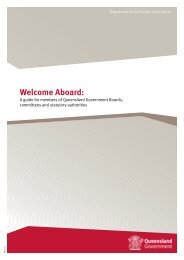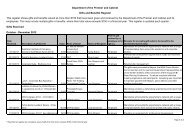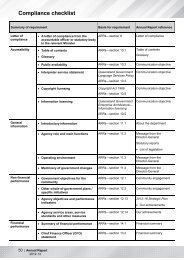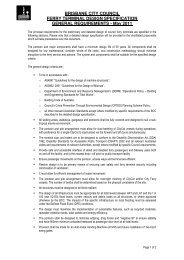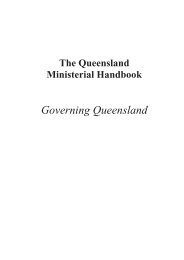Rehabilitative needs and treatment of Indigenous offenders in ...
Rehabilitative needs and treatment of Indigenous offenders in ...
Rehabilitative needs and treatment of Indigenous offenders in ...
Create successful ePaper yourself
Turn your PDF publications into a flip-book with our unique Google optimized e-Paper software.
2008-09. The comb<strong>in</strong>ed total completion rate for female <strong>Indigenous</strong> <strong>of</strong>fendersparticipat<strong>in</strong>g <strong>in</strong> <strong>Indigenous</strong>-specific programs for the three year period is 74per cent. This is similar to the male <strong>Indigenous</strong> completion rate at 72 per cent.Table 6.8: End<strong>in</strong>g Offend<strong>in</strong>g <strong>and</strong> End<strong>in</strong>g Family Violence Programs, FemaleOffenders2006-07 2007-08 2008-09<strong>Indigenous</strong>Non-<strong>Indigenous</strong><strong>Indigenous</strong>Non-<strong>Indigenous</strong><strong>Indigenous</strong>Non-<strong>Indigenous</strong>Complete 20 91% 3 100% 38 68% 2 40% 59 73% 1 100%Incomplete 2 9% 0 0% 18 32% 3 60% 22 27% 0 0%TotalEnrolments 22 3 56 5 81 1Source: QCS, IOMSLiteracy <strong>and</strong> Numeracy ProgramQCS provides literacy <strong>and</strong> numeracy courses which assist <strong>of</strong>fenders further toaccess other courses or programs dur<strong>in</strong>g custody <strong>and</strong> which aim to contributeto successful re<strong>in</strong>tegration post-release. Individual <strong>of</strong>fenders may enrol <strong>in</strong>more than one literacy or numeracy course <strong>in</strong> any given f<strong>in</strong>ancial year.<strong>Indigenous</strong> <strong>of</strong>fender enrolments <strong>in</strong> literacy <strong>and</strong> numeracy courses have<strong>in</strong>creased s<strong>in</strong>ce 2006-07. As a proportion <strong>of</strong> all enrolments, <strong>Indigenous</strong><strong>of</strong>fender enrolments account for 11 per cent <strong>in</strong> 2006-07, 12 per cent <strong>in</strong> 2007-08 <strong>and</strong> 15 per cent <strong>in</strong> 2008-09.Table 6.9 shows that <strong>Indigenous</strong> <strong>of</strong>fenders represent 10 per cent <strong>of</strong> total maleenrolments <strong>in</strong> literacy <strong>and</strong> numeracy courses <strong>in</strong> 2006-07 compared to 11 percent <strong>in</strong> 2007-08 <strong>and</strong> 13 per cent <strong>in</strong> 2008-09. Female <strong>Indigenous</strong>representation <strong>in</strong> literacy <strong>and</strong> numeracy courses is higher than male<strong>Indigenous</strong> representation <strong>and</strong> <strong>in</strong>creases over time. In 2006-07 female<strong>Indigenous</strong> <strong>of</strong>fender enrolments comprise 17 per cent <strong>of</strong> all female <strong>of</strong>fenderenrolments. This grows to 22 per cent <strong>in</strong> 2007-08 <strong>and</strong> 23 per cent <strong>in</strong> 2008-09.It is important to note that although <strong>Indigenous</strong> <strong>of</strong>fender participation <strong>in</strong>literacy <strong>and</strong> numeracy courses has <strong>in</strong>creased over time, such <strong>of</strong>fenders arestill under-represented <strong>in</strong> these courses. Male <strong>Indigenous</strong> <strong>of</strong>fenders accountfor 13 per cent <strong>of</strong> male enrolments <strong>in</strong> 2008-09, but represent 28 per cent <strong>of</strong>the total male prisoner population at 30 June 2009. Female <strong>Indigenous</strong><strong>of</strong>fenders account for 23 per cent <strong>of</strong> female enrolments <strong>in</strong> 2008-09 comparedto 28 per cent <strong>of</strong> the total female prisoner population at 30 June 2009.51



